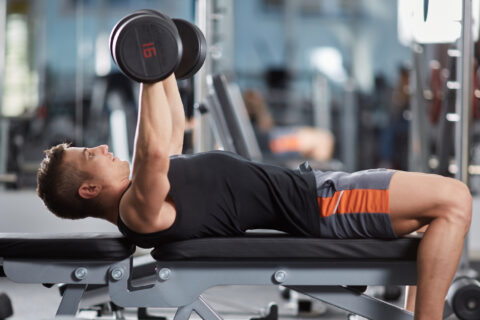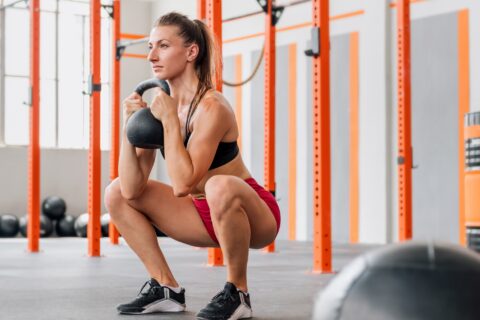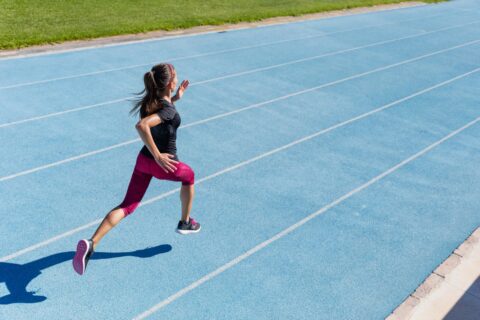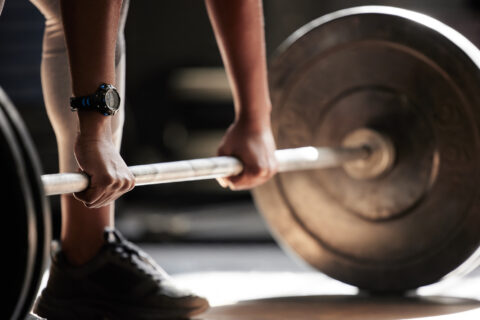Since introducing a few new exercises last week, Week 5 brings back some of the foundational movements and builds on the total volume lifted. With Week 5, if you find that you’re crunched for time, select two out of three main exercises and two out of three accessory exercises. The new exercise this week is a single-leg lower body movement that will challenge your balance, stability, and movement quality.
Before getting started, be sure to warm up well with our Warm-up & Activation Routine.
Week 5 workout at a glance
Front Squat: 4 sets of 10-12 repetitions
Back Squat: 4 sets of 10-12 repetitions
Single-Leg Kettlebell RDL: 3 sets of 6-8 repetitions
Side Plank: 2-3 sets of 30-60 seconds hold per side
Kettlebell Pull-Through: 2-3 sets of 6-8 repetitions per side
Bird Dog: 2-3 sets of 8 repetitions per side
Progressions and regressions
Single-leg kettlebell RDL
If you start with this single-leg RDL and struggle, you can regress it by holding onto a stable item or surface with your free hand. This will help to improve your balance so you can focus on movement quality. If you struggle with flexibility, you could put the kettlebell on a small box or platform to raise it off the ground. This will allow you to work within your individual boundaries of flexibility while still completing the movement with weight.
To progress this movement, I like to start with the weight on the ground and move into the lower position where I will pick up the weight, move to the top, return to the bottom, let go of the weight, grab it again, and repeat. By letting go of the weight each time, I find it helps to reassess body position and ensure movement is coming from the hips, not just from lifting the weight with the arm initially. Finally, to make this even more challenging, you can add an unstable surface under your planted foot like a balance pad.
Pitfalls and warnings
Single-leg kettlebell RDL
- Hip Position: When moving into the lower position, aim to keep your hips “square” to the floor. A common mistake is to allow the hips to open up or collapse as you reach down for or come up with the weight. Focus on a strong and stable core before and throughout the movement. If this is a struggle, refer to the regression notes and try reducing your range of motion to see if you can improve movement quality.
- Knee Position: With beginners, I usually notice a tendency to flex the knee more than necessary when lowering the weight down. This almost turns the movement into a mini single-leg squat + RDL combination. To shift the focus to the hips and work on the hip hinge and drive, keep the planted knee “soft” yet strong. So, it’s not locked out. It has a very slightly flexion (think athletic amount of flexion) that allows for a little natural movement, but not so much that the hips are moving vertically up and down as you raise and lower the weight. Imagine a little 3D dot on your planted hip and visualize that dot remaining stable throughout the movement, limited vertical motion throughout.
- Broken teeter-totter: I like to refer to the motion of the single-leg RDL as resembling a teeter-totter. When your torso moves forward and down, your “free” leg and heel should move backward and up to the same degree. In effect, you maintain a relatively straight line from ears through ankles throughout the movement. In beginners, athletes with limited flexibility, or those with poor single-leg control/stability, I frequently see the torso lowered enough to lift and lower the weight, but the rear/free leg hangs out somewhere behind, not paralleling the movement at the top of the body. It resembles a broken teeter-totter. If you struggle with this, use the regression and raise the kettlebell off the ground so you can work on driving the rear heel high as your torso lowers to the ground.
Want to catch up on previous weeks? Check them out here:
Fast Talk Labs’ Strength Training Series: Week 1
Fast Talk Labs’ Strength Training Series: Week 2
Fast Talk Labs’ Strength Training Series: Week 3
Fast Talk Labs’ Strength Training Series: Week 4
Video Transcript
Ryan Kohler 0:04
Here in Week 5, we’re going to add one new exercise for you. Hopefully over the last couple of weeks, you’ve been able to develop a good base of strength doing these movements on two legs. Today we’re going to add a new one called a single-leg kettlebell RDL. This is going to be a single-leg exercise that will challenge your balance and core stability. So with that, let’s get started with our front squat.
Single-Leg Kettlebell RDL
Ryan Kohler 1:03
So now we have our single-leg kettlebell RDL. We’re going to do six to eight reps for three sets here. So for this one you’ll need a kettlebell on the floor, and the setup for this—what I like to do is kind of put my…well I’ll start with my left foot here—is I have my left foot in alignment with the kettlebell. And then what I’m going to do is just tip forward to pick it up. And as I do that, I start the movement with my rear foot, so I’m not just bending over like this, but I’m bending over and keeping my torso and leg in alignment as best I can. So from there, we come down, pick this up, and then drive back up to the starting position. We’ll slowly lower and then drive back up to that starting position. So we’ll finish up on our one side, put the weight down, we’ll shift over a little bit and then start ourselves up on the next one. So let’s get started.
Side Plank
Ryan Kohler 2:10
Okay, so let’s get into our planks: two to three sets, 30- to 60-second holds on each side.
All right, that’s about it for Week 5. Hopefully you feel like you’ve made some great progress along the way. Next week, we’re coming back with Week 6 and one new exercise for you then. See you next week.



